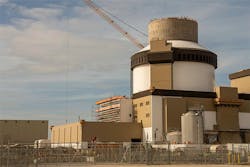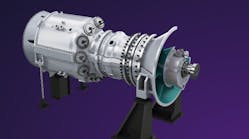Neutrons of Steel: Having the Will to make the case for Nuclear Energy
(Editor's Note: This piece is the opinion of the author and not specifically EnergyTech.)
Nuclear has been on my mind a lot lately.
First thing to catch my attention, of course, was the news that a team at the Lawrence Livermore National Laboratory in California achieved the unprecedented net energy gain from a nuclear fusion experiment. They aimed very powerful mega lasers at a plasma of elements, blasted it with energy and, eureka, created even more power—another additional 1.1 megajoules of energy, to be exact.
The experiment itself was no market changing moment, as it took many years and billions of dollars to reach this incredible goal. They have much, much farther to go. But what it means, with time and more research, includes the possibility of tapping a vast, carbon-free array of nuclear power, without radioactivity-as-a-waste result. Time will tell but this was a scientifically astounding milestone; truly a “first time ever” moment.
I also watched the new Miss America, Grace Stanke, from Wisconsin and a nuclear engineering student at the University of Wisconsin, advocating for the sector and recruiting more women into the industry. Can’t think of a better spokesperson for a baseload resource which could help us reach net zero goals in the energy realm.
And then on the way to spend the Sunday before Christmas with my mom, I listened to a Freakonomics Radio podcast discussing the value of and misinformation against nuclear energy.
Some of this I learned on that drive and some of this I already knew. Key points:
Nuclear energy generates close to 20 percent of the grid-scale electricity in the U.S. and more than half of its carbon-free power. Yet only two new nuclear power projects have come online in the past 30 years due to fears from mishaps such as Chernobyl, Fukushima, Three Mile Island and films such as “The China Syndrome.” Georgia Power's Vogtle Units 3 and 4, nearing completion, are the first new units in years in the U.S., although massive new plants are arising in China, India, Middle East and even the United Kingdom.
New nuclear construction is prohibitively expensive (costing $30B or so for the Vogtle 3 and 4 projects in Georgia) and take more than a decade from regulatory approval to commissioning. However, once completed, the nuclear plant's fuel costs are relatively efficient and low. Factoring in long-term usefulness, considering many nuclear plants will operate for close to 80 years, should pencil in to financial calculations.
Another key positive for nuclear? Energy efficiency: The capacity factor of the average, working nuclear energy power plant is above 90 percent. Capacity factor is the actual electricity generation of a resource divided by the nameplate capacity and number of hours over a given period. In other words, a 3.9 GW facility generating 31.2 million MWh per year would have a capacity factor of 90.4 percent.
Solar and wind farms, considering the sun isn’t always shining and the wind always blowing, have average capacity factors less than half of nuclear. Many solar plants achieve about 20 percent capacity factor while utility-scale wind farms might double that.
A nuclear power plant takes up maybe a square mile worth of land. Next-gen, small modular reactor (SMR) plants may use less than half of that. Meanwhile, solar and wind farms would need perhaps a hundred times the acreage to generate the same level of energy capacity, according to the Nuclear Energy Institute and other resources.
The Freakonomics segment brought up another key point: Danger to human life. The cataclysmic events at Cherynobol and Fukushima caused meltdowns which have impacted public health in the immediate vicinity for many years. These were extraordinary accidents caused by human error, in the former, and a massive natural event (tsunami) in the latter. Those kind of risks understandably terrify people.
The U.S. had its own, less devastating meltdown with Three Mile Island NPP in Pennsylvania back in the late 1970s. But it bears reminding that not a single person died as a result of that event, the worst nuclear energy mishap in American history which completely derailed reactor development for the next three decades. The accident proved that the containment building, which is a feature in every U.S. nuclear plant, did its job. All the damage was confined to the inside of the building.
But let’s look at the numbers which really tell the story: take each power generation resource and study the actual deaths per kilowatt hour. A report by Forbes one decade ago looked at this issue and, combining numerous resources, laid out the “mortality footprint” (my words, not Forbes) of each utility-scale electricity resource. Those statistics factor in construction and operations mishaps, environmental health outcomes and more.
The end result? Coal-fired power globally killed about 100,000 people per trillion kWh (TkWh). As noted, these deaths came through negative respiratory health outcomes as well as immediate things such as construction accidents, etc. The numbers are somewhat skewed because the coal-fired death rate in China was much higher at 170,000 per TKWh.
Second was petroleum oil at 36,000 per TkWh. Coming a distant third was natural gas-fired power at causing 4,000 deaths per TkWh. Biofuel or biomass, considered a growing renewable option by many to eliminate more harmful methane emissions from the atmosphere, was considered to cause more than 24,000 deaths per trillion kWh.
Hydro, wind and solar—the three top renewable and carbon-free energy resources as considered by modern climate advocates—each caused more than 100 deaths per TkWh. How is that possible? Construction accidents, particular with hydro in regions where safety precautions are not observed as much as in the U.S. or other progressive workforce nations, according to the report.
Nuclear, by contrast, causes 90 deaths per trillion kWh globally. In the U.S., it’s 0.1 per TkWh. Much of the data cited by Forbes came from the World Health Organization.
So is nuclear not only more efficient and carbon free than any other energy resource, but also safer? Hysteria-fueled public sentiment may think otherwise, but the statistics here seem to say yes, it is safer, if one is willing to examine beyond hype and age-old headlines to what real findings show.
European nations, frightened by the Middle East oil crisis of the early 1970s, temporarily embraced nuclear power to solidify their energy security. The renewables movement and fear in the fallout over Fukushima, inspired those nations to begin pulling away from nuclear fission to create power. The struggle they now face over a dependance to Russian gas is evident to all.
Radioactive waste from spent fuel is another massive health concern, and rightly so, but the U.S. Energy Department and other, more individual sources, have worked to debunk myths about storage volume. Ronald Reagan once said that entire amount of nuclear waste each year from U.S. power plants could fit under a desk. Microsoft founder Bill Gates said that nuclear energy’s safety record is better than any other kind.
Energy-aware thinkers from all side of the political spectrum are starting to see that Net Zero goals may be impossible without a sizable expansion of clean, flexible energy. SRM facilities with lower footprints and costs may eventually power data centers and other “macro” microgrids someday. All that stands in the way are public opinion, historical misinformation and regulatory hurdles.
And if the dream of nuclear fusion truly develops into a utility-scale resource, the power generation sector could lead the Road to a Carbon-free Energy world.
Do we have the power of the sun in the palm of our hand, as Doc Ock said in “Spiderman 2?” Maybe, maybe not.
Will Hollywood ever give us a film which tells the positive side of nuclear energy? No. Has it ever presented the positive side of the oil revolution, an energy breakthrough which created untold millions of jobs and incalculable improvement in the economic quality of life?
Instead, smart and unbiased people from outside the nuclear sector have to take up the cause. What we assuredly do have is new thinking on how to make nuclear energy relevant again.
The momentum is renewed, perhaps, if only politics isn't as radioactive as it has been.
-- -- --
(Rod Walton, senior editor for EnergyTech, is a 14-year veteran of covering the energy industry both as a newspaper and trade journalist. He can be reached at [email protected]).
Follow us on Twitter @EnergyTechNews and @rodwaltonelp and on LinkedIn.





